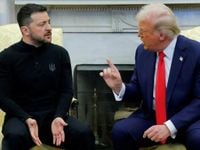It was supposed to be a high-stakes diplomatic meeting with hopes of progress, but what transpired at the White House on October 17, 2025, was anything but calm. According to multiple reports, including the Financial Times and The Daily Beast, the encounter between U.S. President Donald Trump and Ukrainian President Volodymyr Zelensky quickly devolved into a fiery shouting match, marked by discarded battlefield maps, sharp exchanges, and accusations of disrespect.
Sources familiar with the meeting paint a vivid picture: President Trump, visibly frustrated, urged Zelensky to accept Russia’s terms for ending the ongoing conflict. Trump insisted that Ukraine surrender the Donbas region, a demand that echoed Russian President Vladimir Putin’s own talking points. At one point, Trump reportedly told Zelensky, "If [Putin] wants it, he will destroy you," a stark warning that underscored the pressure being placed on Ukraine’s leader.
For Zelensky, the message was clear—and wholly unacceptable. He flatly rejected any suggestion of ceding Ukrainian territory, reaffirming his country’s commitment to defending its sovereignty. As Financial Times reported, the Ukrainian president was unwavering, even as Trump discarded battlefield maps in frustration and the conversation turned heated, with cursing and raised voices throughout.
The meeting, which Zelensky had hoped would result in the U.S. providing long-range Tomahawk missile supplies, ultimately left him empty-handed. According to AFP, Zelensky’s trip to Washington was part of a broader effort to capitalize on what he perceived as Trump’s growing frustration with Putin, especially after a recent summit in Alaska failed to yield a breakthrough. But the outcome was disappointing for Ukraine, with Zelensky returning home without the much-needed military support.
Upon his return, Zelensky took to social media to urge allies against appeasing Russia. "Ukraine will never grant terrorists any bounty for their crimes, and we count on our partners to uphold this very position," he declared, calling for "decisive steps" from European and American allies. The Ukrainian leader’s sense of urgency was palpable, especially as Russian attacks on Ukrainian civilian infrastructure had intensified in the preceding week. According to AFP, more than 3,270 attack drones, 1,370 guided aerial bombs, and nearly 50 missiles had been used by Russia against Ukraine, leaving thousands without heating or electricity as winter approached.
Tragically, on October 19, two people were killed and more than a dozen wounded in Ukraine’s east due to continued Russian strikes, Kyiv officials reported. In response, Ukraine ramped up its own attacks on Russian western border regions and critical oil and gas facilities. Over the weekend, chemical and gas plants in two Russian regions more than a thousand miles from the front line were damaged, according to local governors.
Meanwhile, the Russian army claimed to have captured two villages in Ukraine’s Donetsk and Zaporizhzhia regions, as the conflict ground on in costly, meter-by-meter battles. Both sides reported intercepting dozens of drones launched against each other overnight, highlighting the relentless pace and destructive capacity of the war.
Amid this backdrop, the diplomatic fallout from the White House meeting was immediate and far-reaching. European officials, speaking to the Financial Times, expressed concern that Trump had repeated many of Putin’s arguments verbatim, telling Zelensky he was losing the war and suggesting that the only way forward was to accept the current battle lines. "You have a battle line right now. The rest is very tough to negotiate," Trump later told reporters on Air Force One, adding, "I think 78 percent of the land is already taken by Russia. You leave the land as it is right now. They can negotiate something later on down the line. But I said, ‘Stop the battle, go home, stop fighting, stop killing people’."
Despite Trump’s public insistence that he and Zelensky "never discussed" surrendering the Donbas region, sources present at the meeting—and several European diplomats—maintained that Trump’s demands were explicit. He reportedly pressured Zelensky to accept Russia’s terms for a ceasefire, which included surrendering not just part, but the entire Donbas region to Putin.
The mood among European leaders after the meeting was described as "pragmatic but not optimistic." One official told the Financial Times that Zelensky "was very negative" following the encounter, a sentiment that seemed to reflect the broader sense of uncertainty about the next steps. The meeting also revived memories of Zelensky’s infamous Oval Office visit in February, when he was berated by U.S. Vice President JD Vance for not expressing enough gratitude for American support and was reportedly criticized for not wearing a suit and tie—a detail that some saw as symbolic of deeper tensions between the two allies.
The shouting match between Trump and Zelensky came just days after Trump reportedly spoke by phone with Putin, congratulating him on the “Great Accomplishment of Peace in the Middle East.” Trump suggested that his "Success in the Middle East will help in our negotiation in attaining an end to the War with Russia/Ukraine." He went on to announce, via Truth Social, that high-level advisors from the U.S. and Russia would meet the following week at an undisclosed location, followed by a personal meeting between Trump and Putin in Budapest, Hungary. The choice of Budapest was laden with irony, as it was the site where Russia once signed an agreement promising never to invade Ukraine.
For Ukraine, the diplomatic setbacks and military challenges have only underscored the need for continued international support. Zelensky’s call for "decisive steps" from allies was not just a plea for weapons, but a warning against any move to appease Russia at Ukraine’s expense. "Ukraine will never grant terrorists any bounty for their crimes," he reiterated, hoping to rally European and American partners even as battlefield realities grow more daunting.
As both sides brace for the next phase of the conflict, the world watches closely. The explosive White House meeting may have closed one chapter of diplomatic engagement, but it has opened new questions about the future of U.S. support for Ukraine, the prospects for peace, and the cost of compromise. For now, Zelensky stands firm, determined not to yield—no matter how fierce the pressure from friend or foe alike.

